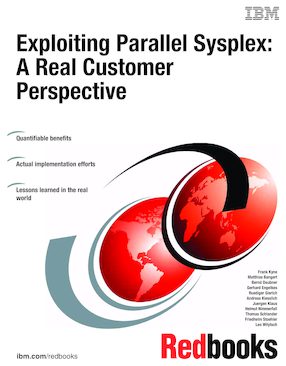Exploiting Parallel Sysplex: A Customer Perspective
An IBM Redbooks publication
Note: This is publication is now archived. For reference only.

Published on 19 October 2006, updated 29 January 2007
ISBN-10: 0738494976
ISBN-13: 9780738494975
IBM Form #: SG24-7108-00
Authors: Frank Kyne, Matthias Bangert, Bernd Daubner, Gerhard Engelkes, Ruediger Gierich, Andreas Kiesslich, Juergen Klaus, Helmut Nimmerfall, Thomas Schlander, Friedhelm Stoehler and Leo Wylitch
IBM System z is well known for its reliability, availability, and serviceability (RAS). So how can your enterprise obtain all this benefit, along with low total cost of ownership (TCO) and excellent centralized administration? And what other benefits can you realize by implementing a Parallel Sysplex configuration? This IBM Redbooks publication answers these questions by documenting the experiences of a real life client that undertook this process. Informatik Zentrum Frankfurt und München (IZB) completed a Parallel Sysplex implementation, and it shares its perspective with you in this detailed analysis.
IZB is a large banking service provider in Germany. Five years ago, it had two data centers with differing standards, no sysplexes, underpowered hardware, and an expensive, tape-based disaster recovery strategy. It lacked DASD or tape mirroring; it needed to customize systems for each client; and it could not aggregate CPUs, resulting in elevated software licensing costs. Today, by exploiting Parallel Sysplex features, IZB is achieving maximum service levels and financial value from its System z environment, and looking forward to growing its client base.
This publication provides step-by-step information about how IZB set up its System z environment. Covering the areas of processors, disk, networking, middleware, databases, peripheral output, and backup and recovery, the book was written to demonstrate how other installations can derive similar value from their System z environments.
Part 1. Overview and Configuration
Chapter 1. Introduction to IZB
Chapter 2. Developing a multi-site data center
Chapter 3. Network considerations
Part 2. Middleware
Chapter 4. CICSPlex
Chapter 5. DB2 data sharing
Chapter 6. Adabas data sharing guideline
Chapter 7. WebSphere
Part 3. The system environment
Chapter 8. Storage management
Chapter 9. System
Chapter 10. Output management
Chapter 11. Automation